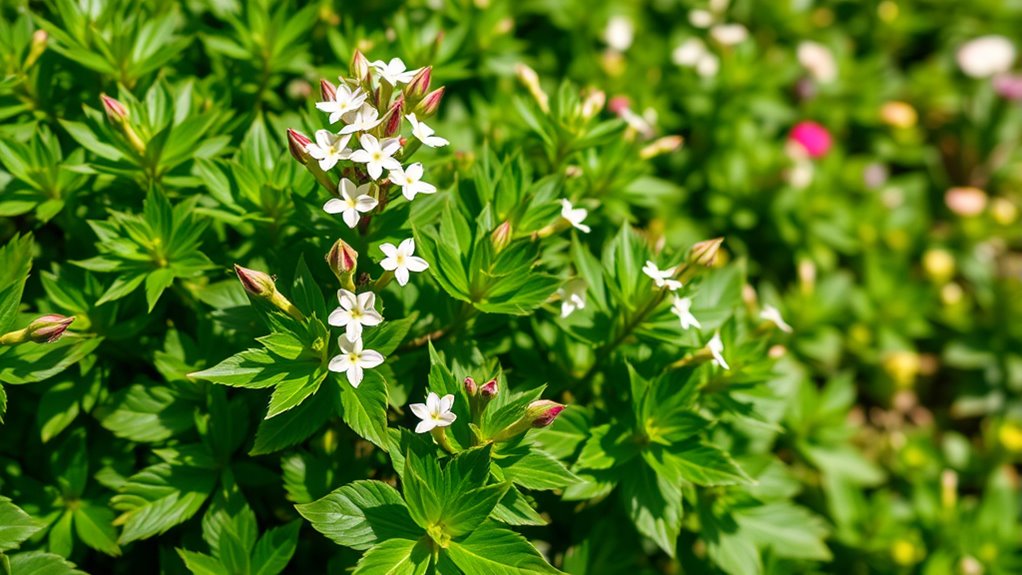If your phlox isn’t blooming, start by checking if it gets at least 6 hours of direct sunlight daily, as too much shade can prevent flowering. Confirm you’re pruning properly by deadheading faded flowers and cutting back stems at the right times to promote new growth. Also, examine your fertilization habits—use a balanced, low-nitrogen fertilizer and avoid overfeeding, which can lead to lush foliage but fewer blooms. For more helpful tips, keep exploring how sunlight, pruning, and fertilizing affect your phlox’s beauty.
Key Takeaways
- Ensure your phlox receives at least 6 hours of full sun daily for optimal flowering.
- Avoid excessive or late-season fertilization, especially with high nitrogen, which promotes foliage over blooms.
- Prune dead or overcrowded stems after flowering to encourage new growth and more blooms.
- Check soil pH; adjust with lime or sulfur to maintain proper nutrient uptake for better flowering.
- Maintain consistent watering and good soil drainage to prevent stress and support healthy flower development.
Assessing Sunlight Requirements for Healthy Blooms
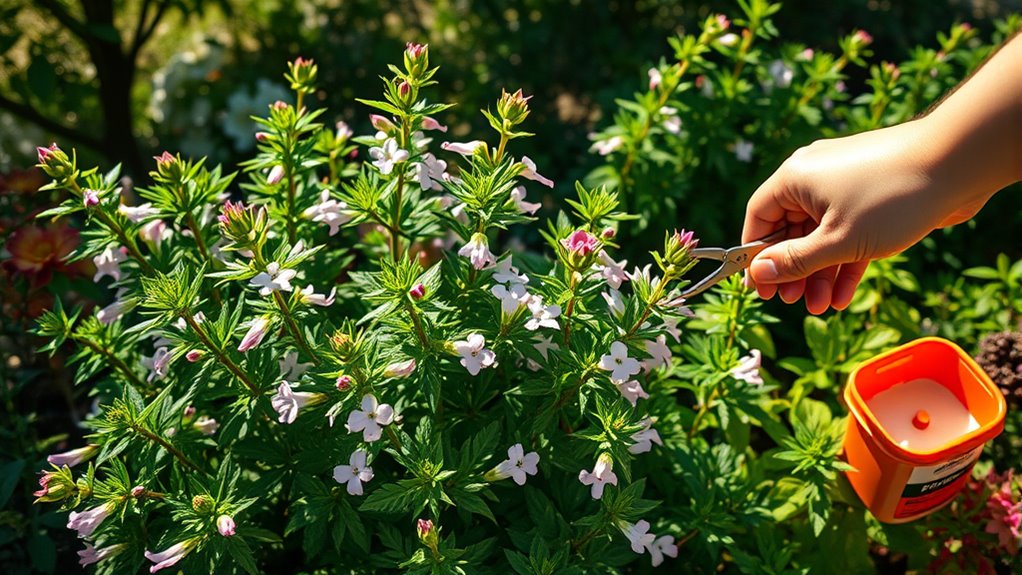
To guarantee your phlox blooms beautifully, it’s essential to understand its sunlight needs. Start with a thorough sunlight assessment of your garden area. Phlox generally prefers full sun, which means at least six hours of direct sunlight daily. However, some varieties exhibit shade tolerance and can tolerate partial shade. Observe how sunlight moves across your garden throughout the day to identify the best spot. If your phlox is placed in too much shade, it may struggle to produce flowers. Conversely, too much direct sun might scorch the foliage. Knowing your plant’s shade tolerance helps you choose the best location, ensuring healthy growth and vibrant blooms. Proper sunlight assessment is fundamental for creating the ideal environment for your phlox to thrive. Additionally, understanding how AI tools assist in data analysis can help you monitor light patterns and optimize your garden layout for optimal flowering conditions. Recognizing the importance of garden microclimates can further refine your placement decisions, ensuring your phlox receives the most suitable growing conditions.
Proper Pruning Techniques for Encouraging Flowering

Proper pruning is vital for encouraging your phlox to produce abundant flowers. Start by using sharp pruning tools to make clean cuts, which help prevent disease and promote healthy growth. Deadheading techniques are essential; regularly remove spent flower heads just above the next set of buds. This encourages the plant to focus energy on producing new blooms instead of seed production. When pruning, cut back faded stems to healthy growth points, ideally just above a leaf node. Avoid heavy pruning late in the season, as it can reduce flowering the following year. Consistent deadheading and careful trimming stimulate continuous flowering and maintain your phlox’s overall health. Additionally, regular assessment and rotation of tools can help maintain their effectiveness and promote healthier pruning practices. Incorporating proper pruning techniques aligned with plant health principles can further enhance flowering. Recognizing the importance of plant health fundamentals ensures your pruning efforts support sustained blooming.
The Role of Fertilizer in Phlox Flower Production
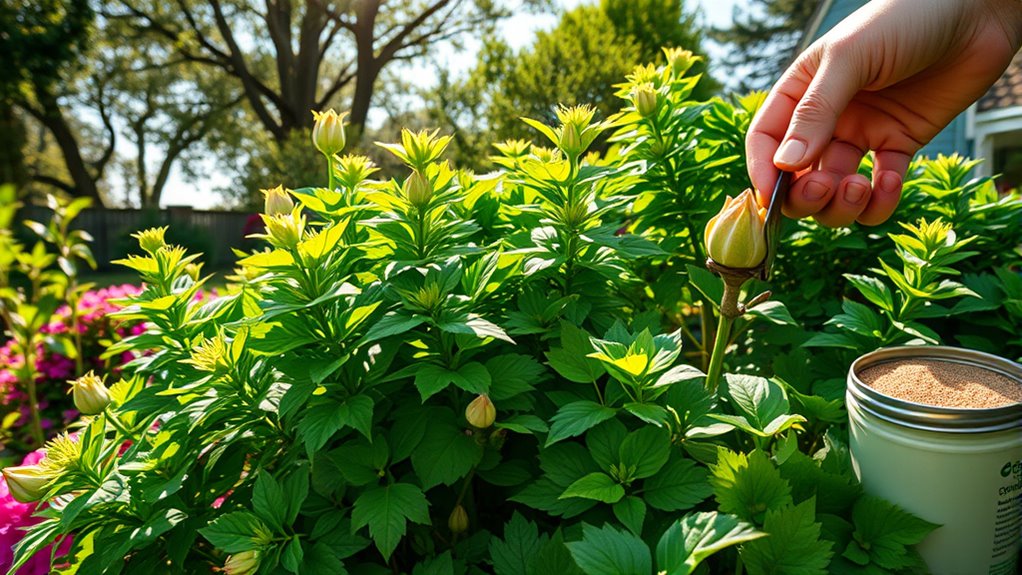
Choosing the right fertilizer and applying it at the right time can make a big difference in your phlox’s flowering. Using proper types and avoiding overfeeding helps promote healthy blooms without harming the plant. Keep these tips in mind to encourage vibrant, abundant flowers. Additionally, selecting fertilizers with appropriate nutrient balances can support overall plant health and flowering success Glycolic acid benefits.
Proper Fertilizer Types
Using the right fertilizer types is essential for encouraging healthy flowering in your phlox. A balanced, low-nitrogen fertilizer promotes vibrant blooms without encouraging excessive leaf growth. Look for a formula with phosphorus to boost flower production and potassium for overall plant health. Proper fertilization also helps strengthen your phlox’s defenses against garden pests and disease. Healthy, well-nourished plants are less vulnerable to infestations and infections, which can hinder flowering. Avoid high-nitrogen fertilizers that encourage lush foliage at the expense of blooms. Instead, opt for slow-release fertilizers or organic options like compost or bone meal. Applying the correct fertilizer in the right amount ensures your phlox remains vigorous, pest-resistant, and capable of producing stunning flowers throughout the season.
Application Timing Tips
Timing your fertilizer applications is essential for maximizing phlox flowering. Applying fertilizer at the right moments ensures healthy growth and vibrant blooms. Typically, fertilize early in the growing season to give your plants a strong start, then again after the first flush of flowers to encourage continued blooming. Proper timing also supports your garden design goals by creating lush, colorful displays. Remember, well-timed fertilization can help your plants resist pests better, reducing the need for chemical control. Here’s a helpful guide:
| When to Fertilize | Why it Matters | Effects on Your Garden |
|---|---|---|
| Early Spring | Boosts growth | Fuller, taller plants |
| Mid-Season | Promotes blooms | Longer flowering period |
| Post-Bloom | Strengthens roots | Healthier, pest-resistant plants |
Avoid Overfeeding Risks
While fertilizer is essential for healthy phlox growth, overfeeding can considerably hinder flower production. Excess nutrients encourage lush foliage at the expense of blooms, leading to weak stems and fewer flowers. Overfeeding can also increase the risk of plant disease and pest problems, as dense foliage creates a humid environment that fosters disease development. To avoid this, apply fertilizer sparingly and follow recommended guidelines. Proper feeding supports plant health without overwhelming it, reducing the need for intensive pest control strategies later. Keep an eye out for signs of overfeeding, such as yellowing leaves or stunted blooms. Maintaining balanced nutrition not only promotes vibrant flowers but also enhances plant resilience, ensuring your phlox remains healthy and blooms profusely. Additionally, understanding how nutrition impacts plant health can help you optimize your fertilization practices for better flowering. Being aware of how proper fertilization influences overall plant vitality can also guide your care routine and prevent issues related to overfeeding.
Identifying and Addressing Common Environmental Stressors
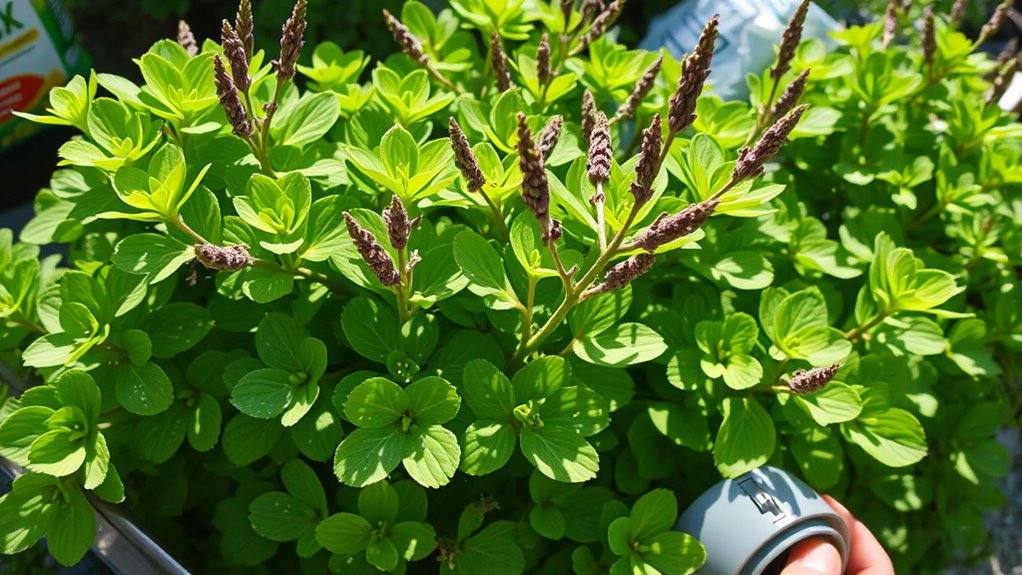
Environmental stressors are often the main reason why your phlox isn’t flowering as expected. To help your plant thrive, identify and address these issues promptly. Regularly inspecting your plant for pests like aphids or spider mites can prevent infestations and keep it healthy. Disease prevention is also crucial; look for signs of fungal or bacterial diseases, such as discolored spots or wilting. Proper spacing and air circulation reduce disease risks. Additionally, ensuring your phlox isn’t exposed to harsh winds, extreme temperatures, or excessive shade helps prevent stress and promotes flowering. Adjusting these factors improves overall health. Understanding environmental conditions and their impact on plant health can greatly enhance your gardening success. Recognizing plant stressors early can make a significant difference in encouraging blooms. Monitoring soil moisture levels is also vital, as both overwatering and drought stress can hinder flowering.
Ensuring Adequate Watering and Soil Conditions
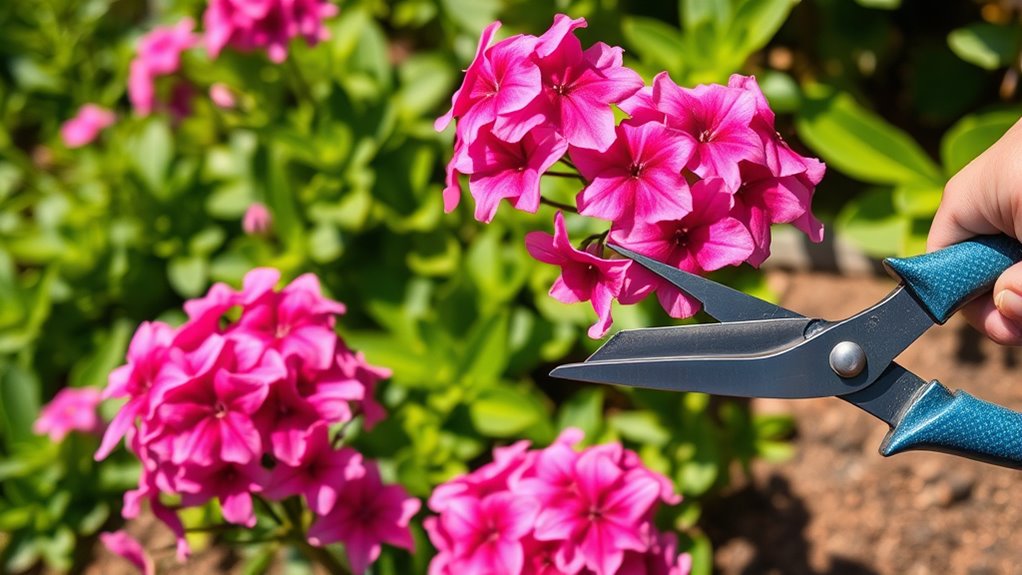
Make certain your phlox receives consistent moisture without becoming waterlogged, as uneven watering can hinder blooming. Use well-drained soil to prevent root rot and keep your plants healthy. Checking and adjusting the soil’s pH ensures your phlox has the best environment to produce vibrant flowers. Additionally, understanding the importance of soil health can help you maintain optimal growing conditions for your plants. Proper watering techniques are essential for avoiding issues related to over- or under-watering, which can also affect flowering. Incorporating tuning practices to optimize your plant care routine can further promote healthy blooms.
Consistent Moisture Levels
Maintaining consistent moisture levels is essential for encouraging phlox to produce vibrant blooms. When your watering habits are steady, the roots stay healthy and prevent stress that can hinder flowering. Guarantee the soil remains evenly moist but not soggy, as uneven watering can lead to problems like root rot or pest infestations. To achieve this:
- Water deeply and regularly, especially during dry spells, to keep the soil consistently moist.
- Mulch around your plants to trap moisture and regulate soil temperature.
- Monitor soil moisture frequently to avoid overwatering or underwatering, adjusting your watering habits as needed.
Consistent moisture supports healthy growth and helps pest management, preventing conditions that attract pests or promote disease. This balance encourages your phlox to focus energy on blooming.
Well-Drained Soil Needed
Ensuring well-drained soil is crucial for healthy phlox growth and vibrant blooms. Poor drainage can lead to root rot and weaken the plant, preventing flowering. When designing your garden, choose a site with good airflow and avoid low spots where water pools. Incorporate organic matter to improve soil structure and guarantee excess water escapes easily. Proper soil drainage also supports pest control, as damp, stagnant soil attracts pests like slugs and fungi. Regularly check your soil’s drainage capacity and adjust your garden design if needed. Proper watering techniques, combined with well-drained soil, help keep your phlox healthy and encourage flowering. By paying attention to these factors, you create an ideal environment for your plants to thrive and bloom beautifully.
Proper Soil Ph Balance
A balanced soil pH is essential for phlox to absorb nutrients effectively and thrive. If your soil is too acidic or alkaline, your plants may struggle to produce flowers. To guarantee proper soil conditions, perform pH testing regularly. Based on the results, you might need a soil amendment to adjust the pH level. Here are key steps:
- Test your soil’s pH to identify its current level.
- Add lime if the soil is too acidic, or sulfur if it’s too alkaline.
- Incorporate organic matter to improve overall soil health and water retention.
- Using the right shower fixtures can help maintain consistent watering routines, which support soil health and plant growth.
Maintaining the right pH helps your phlox absorb nutrients better and encourages vibrant blooms. Proper watering also supports soil health, creating ideal conditions for flowering.
Timing and Seasonal Care to Maximize Flowering Results
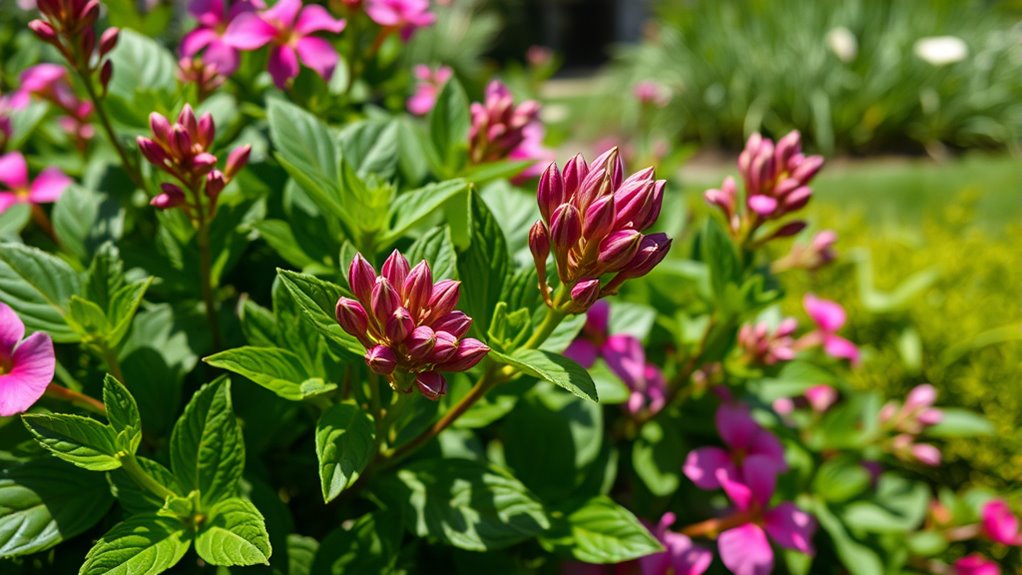
Timing your phlox’s care throughout the year is essential for encouraging vibrant blooms. You should follow proper pruning schedules, trimming back dead or overcrowded stems after flowering to promote healthy growth. Pruning at the right time prevents disease and encourages new blooms. Additionally, fertilizer application should be scheduled to support flowering; apply a balanced fertilizer in early spring and again halfway through the growing season. Avoid fertilizing late in the season, as this can encourage lush foliage instead of flowers. Keep a consistent watering schedule and monitor seasonal changes to adjust care accordingly. Proper timing ensures your phlox receives the nutrients and maintenance it needs to produce abundant, colorful flowers year after year. Understanding plant growth cycles can help you better tailor your care practices for optimal flowering.
Frequently Asked Questions
How Do I Prevent Pests From Damaging My Phlox Flowers?
To prevent pests from damaging your phlox flowers, focus on pest prevention by regularly inspecting your plants and removing any insects or eggs you spot. Use natural predators like ladybugs or apply insecticidal soap for effective pest control. Good disease management also helps keep pests at bay. Keep your phlox healthy by ensuring proper watering and spacing, which reduces stress and makes it less attractive to pests.
Can Over-Fertilizing Harm My Phlox’S Flowering Ability?
Imagine you’re at a medieval feast, but too much spice ruins the flavor—that’s like fertilizer overdose for your phlox. Over-fertilizing can harm your plant’s flowering by causing bloom suppression, as excess nutrients disrupt its natural growth cycle. Too much fertilizer, especially high in nitrogen, stresses the plant and prevents it from producing blooms. To keep your phlox happy, follow recommended fertilizing guidelines and avoid overdoing it.
What Are Signs of Nutrient Deficiencies in My Phlox?
If your phlox shows leaf discoloration and stunted growth, it may have nutrient deficiencies. Look for yellowing leaves, which indicate nitrogen shortages, or purpling leaves suggest phosphorus deficiency. Pale or weak stems can also signal potassium deficiency. These signs point to the need for balanced fertilization. Regularly check your plant’s leaves and growth habits to catch deficiencies early, and consider applying appropriate fertilizers to restore health and promote flowering.
How Does Soil Ph Affect Phlox Blooming?
Think of your soil’s pH like a recipe’s balance—it needs to be just right. If your soil’s too alkaline or acidic, it can prevent phlox from blooming. Soil acidity affects nutrient uptake, so a pH adjustment might be necessary to access vibrant flowers. Testing your soil and maintaining a balanced pH ensures your phlox thrives, encouraging those beautiful blooms you’re hoping for.
When Is the Best Time to Transplant Phlox for Optimal Flowering?
You should transplant your phlox during early spring or fall, when the plant isn’t actively blooming. Timing considerations are vital for successful transplanting, so avoid hot summer months. Use gentle transplant methods, like digging around the root ball and keeping soil moist to minimize stress. This guarantees the plant establishes well and boosts its chances for vibrant blooms next season. Always water thoroughly after transplanting to support healthy growth.
Conclusion
By paying attention to sunlight, pruning, and fertilizer, you can turn your phlox into a blooming masterpiece. Think of your garden as a symphony; each note—water, soil, and care—must harmonize for the best performance. Keep an eye on environmental stressors and seasonal needs, and your phlox will reward you with vibrant blooms. With a little patience and care, you’ll soon see your garden bursting with color, like a painter’s palette coming to life.
